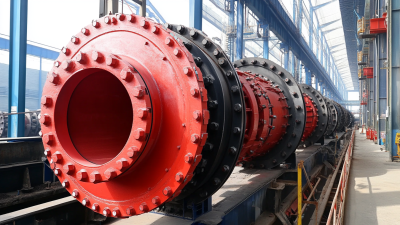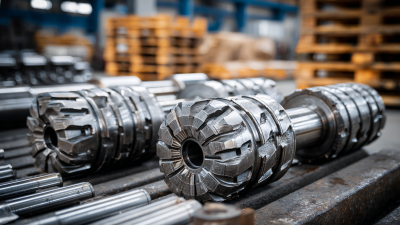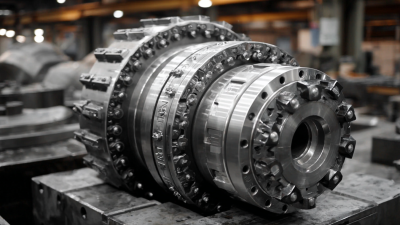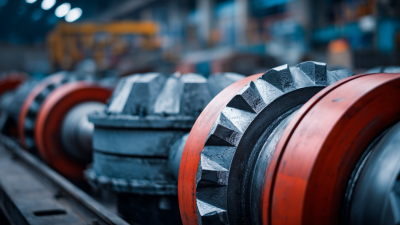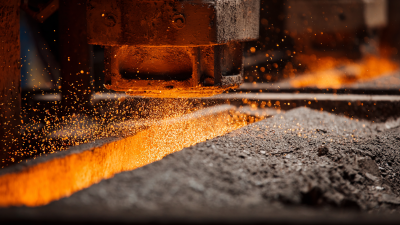
-
Home
-
About Us
-
Products
-
News
-
Blog
-
Contact Us
Leave Your Message

In the rapidly evolving mining and construction industries, the demand for optimal performance and longevity of machinery has never been more critical. Cone crusher parts, crucial components in the crushing processes, play a vital role in determining the efficiency and output of operations. According to a report by Grand View Research, the global cone crusher market is expected to reach $2.9 billion by 2025, driven by the increasing demand for construction aggregates and minerals. This highlights the significance of investing in high-quality cone crusher parts to maximize productivity and minimize downtime.

This ultimate guide will delve into the critical aspects of cone crusher parts, providing valuable insights and expert recommendations for enhancing performance and extending the lifespan of your equipment. By leveraging industry data and expert analysis, operators can make informed decisions that lead to improved operational efficiency and cost savings.
Understanding the various components of a cone crusher is crucial for achieving optimal functionality and ensuring the longevity of the equipment. Cone crushers are complex machines that comprise numerous parts, including the mantle, bowl liner, and eccentric bushing, each playing a pivotal role in the crushing process. According to a report from the Mining Association, proper maintenance and understanding of these parts can extend the lifespan of the crusher by up to 30%. By recognizing how each part interacts within the system, operators can diagnose issues more efficiently and implement timely maintenance strategies.
Moreover, insight into the specific roles of cone crusher parts can lead to improved performance metrics. For instance, the use of high-quality materials for the mantle and bowl liners can significantly enhance wear resistance, thus minimizing downtime and maintenance costs. An industry survey indicated that operations with a comprehensive understanding of their equipment's components experienced a 25% increase in throughput and a reduction in operational costs by about 15%. This data highlights the critical nature of investing time and resources into understanding the intricacies of cone crusher parts, ultimately driving both efficiency and profitability in mining and aggregate operations.
Cone crushers are essential in various industries, particularly in mining and aggregate production, where their efficiency directly impacts overall operational performance. Understanding the key components of cone crushers is crucial for maintaining their functionality and ensuring longevity. The main parts include the mantle, concave, and the bowl liner, all of which work together to crush materials. The mantle and concave, typically made from high manganese steel, account for a significant portion of the wear in a cone crusher, with reports indicating that these components can wear up to 20% faster if not properly maintained.
Additionally, the use of advanced materials, such as alloy steel and carbon chrome steel, has been shown to enhance the durability of these components. According to a study by Mining and Construction Technology, high-quality liners can substantially increase the service life by 30-50%, reducing downtime and maintenance costs. Furthermore, ensuring the correct design of the feed opening and discharge settings is critical, as improper configurations can lead to inefficiencies and premature wear. Regular evaluation and timely replacement of these key components not only optimize performance but also enhance the overall lifespan of the cone crusher, making it a cost-effective investment for operators in today's competitive market.
When it comes to optimizing the performance and lifespan of cone crushers, selecting quality wear parts is crucial. The right replacements can significantly enhance the operational efficiency and durability of these machines. Key components such as the mantle, concave, and bowl liner often experience the greatest wear during standard operation. Utilizing high-grade materials for these parts can lead to extended service life, reduced operational costs, and improved overall productivity.
Incorporating wear-resistant alloys and technologies can result in substantial savings for mining and aggregate operations. For instance, advanced metallurgy in liners and mantles prevents premature failures and maintains effective crushing performance. Moreover, regular maintenance schedules and timely replacements of these wear parts ensure that the cone crusher operates at its best. By focusing on high-quality, durable replacements, operators can maximize the service life of their equipment while ensuring consistent output and reducing downtime.
The efficiency of a cone crusher significantly hinges on the quality and condition of its parts. Key components such as the mantle, concave, and bowl liner play a crucial role in determining the crusher's ability to break down materials effectively. Regular monitoring and timely replacement of these parts can lead to enhanced performance, reducing the likelihood of breakdowns and improving overall productivity. When these parts are well-maintained, they ensure a consistent gap between the crushing surfaces, promoting optimal material flow and reducing the wear and tear on the machinery.
Furthermore, effective performance metrics are essential for analyzing how these parts affect the efficiency of a cone crusher. Metrics such as throughput, reduction ratio, and energy consumption provide insights into the operational effectiveness of the crusher. By assessing these parameters, operators can identify potential performance bottlenecks related to specific parts. This data-driven approach enables them to make informed decisions about part upgrades and maintenance schedules, ultimately leading to increased lifespan and reliability of the cone crusher in various applications.
| Part Name | Material | Impact on Efficiency | Maintenance Frequency | Average Lifespan (Hours) |
|---|---|---|---|---|
| Mantle | Manganese Steel | High wear resistance improves crushing efficiency | Every 2000 hours | 1500-3000 |
| Concave | Manganese Steel | Affects product granulation and throughput | Every 1800 hours | 1500-3500 |
| Spider Bushing | Bronze | Critical for rotor alignment and stability | Every 3000 hours | 5000+ |
| Eccentric Shaft | Steel Alloy | Directly affects crushing cycle efficiency | Every 4000 hours | 10000+ |
| Drive Ring | Rubber/Steel Composite | Enhances drive efficiency and reduces slippage | Every 5000 hours | 20000+ |
Maintaining your cone crusher parts is crucial for ensuring optimal performance and extending their lifespan. According to a report by Simonson & Associates, regular maintenance can improve equipment longevity by up to 30%. To achieve this, operators should adhere to a strict maintenance schedule that includes routine inspections, lubrication, and adjustments of the cone settings.
One essential tip is to monitor the wear patterns on the liner and mantle. Regularly checking for signs of wear can prevent costly failures and downtime. Data from the Mining Machinery Association indicates that early detection of excessive wear can save operators 20% on replacement costs. Additionally, utilizing high-quality replacement parts can significantly improve your machine's efficiency.
Another best practice involves maintaining proper operational parameters, such as feed size and shape. An improperly fed cone crusher can lead to increased stress on the components, resulting in premature wear. Operators should also train their personnel on best practices for feeding materials to the cone, ensuring an even distribution and reducing risks of wear. Ultimately, implementing these maintenance practices will help achieve enhanced performance and longevity for your cone crusher parts.
